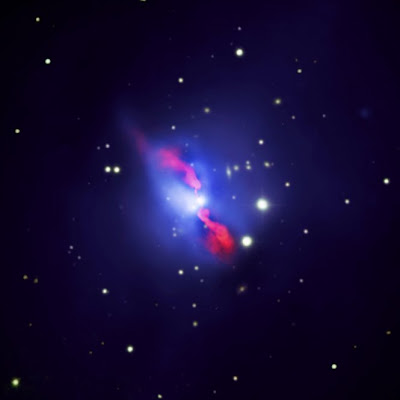
This composite image of the Hydra A galaxy cluster shows 10-million- degree gas observed by Chandra in blue and jets of radio emission observed by the Very Large Array in pink. Optical data from the Canada- France-Hawaii telescope and the Digitized Sky Survey shows galaxies in the cluster.
Detailed analysis of the Chandra data shows that the gas located along the direction of the radio jets is enhanced in iron and other metals. Scientists think these elements have been produced by Type Ia supernova explosions in the large galaxy at the center of the cluster. A powerful outburst from the supermassive black hole then pushed the material outwards, over distances extending for almost 400,000 light years, extending beyond the region shown in this image. About 10 to 20 percent of the iron in the galaxy has been displaced, requiring a few percent of the total energy produced by the central black hole.
Outbursts from the central, supermassive black hole have not only pushed elements outwards, but have created a series of cavities in the hot gas. As these jets blasted through the galaxy into the surrounding multimillion-degree intergalactic gas, they pushed the hot gas aside to create the cavities. A relatively recent outburst created a pair of cavities visible as dark regions in the Chandra image located around the radio emission. These cavities are so large they would be able to contain the entire Milky Way galaxy, but they are dwarfed by even larger cavities -- too faint to be visible in this image - created by earlier, more powerful outbursts from the black hole. The largest of these cavities is immense, extending for about 670,000 light years.
Detailed analysis of the Chandra data shows that the gas located along the direction of the radio jets is enhanced in iron and other metals. Scientists think these elements have been produced by Type Ia supernova explosions in the large galaxy at the center of the cluster. A powerful outburst from the supermassive black hole then pushed the material outwards, over distances extending for almost 400,000 light years, extending beyond the region shown in this image. About 10 to 20 percent of the iron in the galaxy has been displaced, requiring a few percent of the total energy produced by the central black hole.
Outbursts from the central, supermassive black hole have not only pushed elements outwards, but have created a series of cavities in the hot gas. As these jets blasted through the galaxy into the surrounding multimillion-degree intergalactic gas, they pushed the hot gas aside to create the cavities. A relatively recent outburst created a pair of cavities visible as dark regions in the Chandra image located around the radio emission. These cavities are so large they would be able to contain the entire Milky Way galaxy, but they are dwarfed by even larger cavities -- too faint to be visible in this image - created by earlier, more powerful outbursts from the black hole. The largest of these cavities is immense, extending for about 670,000 light years.